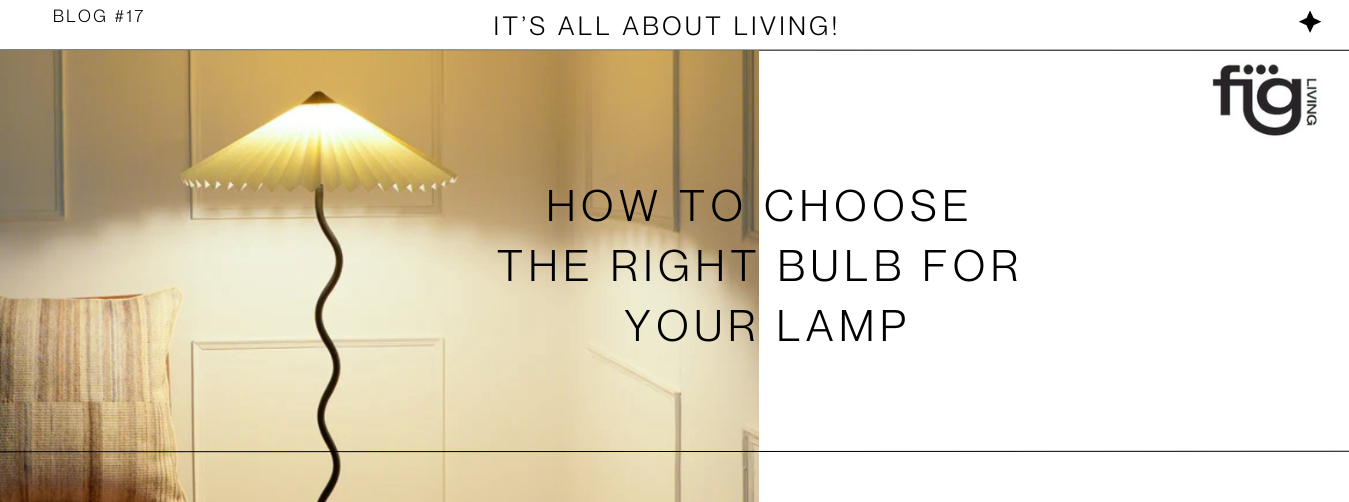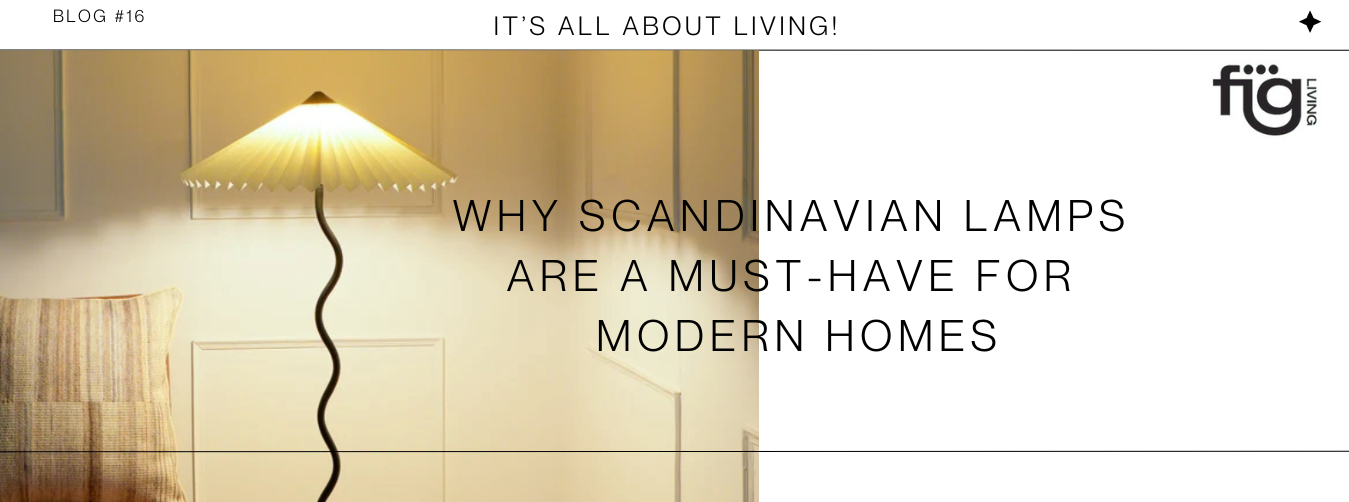
How to Choose the Right Bulb for Your Lamp
To achieve the desired atmosphere and mood in your living area, choosing the ideal lightbulb for your lamp can make all the difference. However, how do you make the best decision? When lighting up a floor lamp, table lamp, or pendant lamp from FigLiving, choosing the right bulb is crucial for both appearance and use. We'll walk you through every step of selecting the appropriate lightbulb for your lamp in this article.

1. Understanding Lamp Types
The first thing to do when selecting a bulb is to identify the kind of lamp you currently have. The bulb size, shape, and light output requirements for various lights differ.
Table Lamps: Table lamps are adaptable and provide a wide range of bulb options. They work great for task lighting and for adding coziness to your living room or bedroom.
Floor Lamps: Floor lamps, which are often larger, give a room ambiance illumination. Higher lumen output bulbs are frequently needed for these.
Pendant Lamps: Although Pendant lamps are usually used for overhead lighting, pendant lamps can also act as a room's main point. They frequently need lightbulbs that not only fit the lamp's style but also offer sufficient illumination.
Understanding the nature of your lamp will help you choose a bulb that best suits its requirements.
2. Why Bulb Type Matters
"Why does the bulb type matter?" one may think. As for light output, color temperature, and energy efficiency, well, they vary amongst bulbs. Selecting the incorrect lightbulb may lead to insufficient illumination or high energy usage, which can have an impact on your comfort level and utility expenses.
For example, a pendant lamp with a high-lumen bulb could produce an uncomfortable, too bright atmosphere, whereas a floor lamp with a low-lumen bulb might not give enough light for a large space. Therefore, choosing the appropriate bulb is essential to guaranteeing that your lamp works well and matches your design.
3. Different Types of Bulbs
Making an informed choice requires having a thorough understanding of the many varieties of bulbs. The primary categories are as follows:
The conventional bulbs that the most of us were raised with are incandescent ones. Although they have a limited lifespan and are not very energy-efficient, they do give a warm light.
Incandescent Bulbs: Available in a range of colors and brightness levels, LED bulbs are renowned for their long lifespan and energy economy. They are a common option for the majority of contemporary lamps.
CFL Bulbs: Compact fluorescent lamps provide a nice balance between brightness and color and are more energy-efficient than incandescent bulbs.
Halogen Bulbs: Frequently utilized in task lighting, these bulbs emit a bright, white light.
Every variety has benefits and downsides. LED bulbs, for instance, have a long lifespan and save a lot of energy, but their initial cost may be higher.
4. Bulb Base Compatibility
Selecting the appropriate bulb base is essential. The base of the bulb needs to fit your lamp's socket. These are a few typical bulb bases:
Edison Screw Base (E26/E27): The most popular screw base for domestic lamps is the Edison (E26/E27).
Candelabra Base (E12): Found in chandeliers and smaller lamps.
Bayonet Base (B22): Common in older lamps or European types is the bayonet base (B22).
Verify compatibility by checking the kind of socket on your lamp before buying a new bulb.
5. Light Output and Lumens
The quantity of light produced by a bulb is measured in lumens. The brightness of the light increases with lumens. Here is a brief how-to:
450 lumens: Perfect for little lamps or accent lighting.
800 lumens: Enough light for medium-sized floor lamps and table lamps.
1100 lumens: 1100 lumens are ideal for larger pendant lamps or floor lamps in larger spaces.
When selecting a lightbulb, it is imperative to take your space's lighting requirements into account.
6. Color Temperature Explained
The mood of a room can be greatly affected by the color temperature of a lightbulb. Kelvin (K) is used to measure it:
2700K-3000K: Warm white, 2700K–3000K, is perfect for setting a comfortable mood.
3500K-4100K: 3500K–4100K: Ideal for task lighting, neutral white color.
5000K-6500K: Daylight, ideal for bright, energizing situations, ranges from 5000K to 6500K.
A lower color temperature light bulb will produce a more tranquil atmosphere in a living room or bedroom, while a higher color temperature light bulb is better suited for kitchens or workstations.
7. Energy Efficiency Considerations
When selecting a lightbulb, energy efficiency is quite important, especially if you want to lower your electricity costs and the influence you have on the environment. This is a contrast:
LED Bulbs: When compared to incandescent bulbs, LED bulbs are the most energy-efficient, saving up to 80% on energy use.
CFL Bulbs: Approximately 70% more efficient than incandescent bulbs, CFL bulbs are moderately efficient.
Incandescent Bulbs: Have a shorter lifespan and are the least energy-efficient.
The greatest option if you want to reduce your energy expenses is to use LED bulbs.
8. Bulb Shapes and Their Impact
The way a light bulb is shaped can affect how the light spreads and how your lamp looks overall. These are a few typical bulb shapes:
A-Shaped: Typical bulb form that works with the majority of lamps.
Globe: Rounder and larger, perfect for vanity or pendant lamp lighting.
Candle: This slim and tapering candle is ideal for decorative fittings like chandeliers.
Tubular: Tubular fixtures and lamps are long and thin in shape.
While choosing a bulb, take into account the design of your lamp and the required light distribution.
9. Specialty Bulbs for Unique Needs
Occasionally, a lightbulb with a particular feature could be required to satisfy special needs.
Dimmable Bulbs: Adjustable brightness is possible with dimmable bulbs, making them perfect for setting various moods.
Smart Bulbs: Provide flexibility and convenience with voice commands or smartphone management.
Color-Changing Bulbs: Excellent for bringing a playful or joyous element to your environment.
Specialty bulbs can improve your lamp's atmosphere and functionality.
10. Budget-Friendly Bulb Options
Selecting a high-quality lightbulb is crucial, but it doesn't have to be expensive. Here are some possibilities that are affordable:
CFL Bulbs: Still offer good energy efficiency, but at a lower cost than LEDs.
Standard LED Bulbs: The more basic types still save a lot of energy and are frequently more reasonably priced.
Halogen Bulbs: A more affordable and energy-efficient replacement for incandescent bulbs.
Finding the ideal lightbulb for your needs might be facilitated by weighing quality and cost.
11. Care and Maintenance of Bulbs
Your lightbulbs can continue to give off their best light for longer with proper care and upkeep. Here are some pointers:
Regular Cleaning: Use a soft cloth to clean lightbulbs on a frequent basis to prevent dirt and dust from lowering their brightness.
Avoid Overheating: Proper ventilation surrounding your lamp is essential to avoid overheating, which can reduce the lifespan of your lightbulb.
Check for Compatibility: Using the incorrect bulb can cause harm to your lamp, therefore before installing, make sure it is compatible.
You may make the most of your bulbs by paying attention to these pointers.
12. FAQs on Choosing the Right Bulb
What is the best bulb for a table lamp?
To create a cozy ambiance, an LED table lamp bulb with 800 lumens and a warm white color temperature (2700K-3000K) is perfect.
How do I know what bulb base my lamp uses?
The lamp's handbook or any marks on the socket will tell you the sort of bulb base. Common bases are E12 (candelabra) and E26/E27 (Edison screw).
Can I use a higher wattage bulb in my lamp?
Verifying the lamp's maximum wattage rating is crucial. When a higher wattage bulb is used than what is advised, the lamp may overheat and sustain damage.
What is the difference between lumens and watts?
Watts are used to measure energy usage, and lumens are used to measure brightness in light bulbs. More light is indicated by more lumens, while more energy is utilized by higher watts.
Are smart bulbs worth the investment?
Energy savings, convenience, and flexibility are all provided by smart bulbs. They are well worth the money if you are tech savvy and would want to have remote control over your lighting.

















